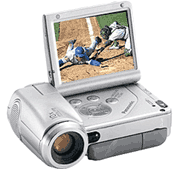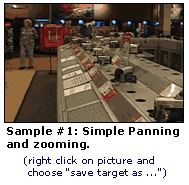 My
Mini-Review and Impression of the Panasonic AV-100 My
Mini-Review and Impression of the Panasonic AV-100
by
Tim Root, MD
Last
updated 12-15-03
I recently
dropped by Circuit City and discovered they had a demo unit of Panasonic's
new AV-100 camcorder. This remarkable little device doesn't use
tapes, but captures video directly onto SD flash cards using the
MPEG-2 and MPEG-4 video formats. The folk at Circuit City let me
play with the unit ... since I happened to have an SD card on me,
I went ahead and recorded a few clips to take home (see clips below).
I'm glad to
see a tapeless device like this as I've always hated transferring
video tapes to my hard-drive. Even with a blazing fast hard drive,
I still run into problems with firewire. Here are my impressions
of the Panasonic AV-100 device:
Size
and Form Factor
Little ... this thing is small. Much smaller than Sony's MicroMV
recorders. The LCD screen was bright, but rotated in a rather odd
manner ... you can reverse the screen for taking self-portraits,
but you can't lay the panel flat when this is reversed (like in
the picture above). Weird. Also, playback of captured video did
not occur full-screen, but appeared in a tiny little window in the
middle of the screen. I don't like the top-mounted microphone placement,
either ... but at least their won't be any motor noise.
Flash
memory:
The device uses SD cards for storage ... hardly surprising since
Panasonic is the major pusher of SD as a memory standard. I would
have preferred Compact Flash cards, as they are much cheaper and
come in larger formats (and also as micro-drives). Over the next
few years I expect all video cameras will have internal hard-drives
like an iPod mp3 player.
MPEG
quality:
Unfortunately, the device uses MPEG compression to save video. While
this format is fine for DVDs, it is not great for those who like
to edit their videos ... MPEG compression loses a lot of quality
with multiple edits. The MPEG2 video that I captured seems pretty
good: not nearly DV-AVI quality, but better than Hi-8. I would avoid
using MPEG4 settings as it is difficult to import MPEG4 into other
editing or DVD-creation programs.
What's with
the MPEG4 format anyway? Sure, it's small size is great for displaying
and sharing videos ... but a highly compressed format like this
sucks for raw-video capturing and editing.
Hopefully,
the device will come with editing software to splice out clips without
re-encoding the MPEG2 video. This may be an in-camera function,
but I didn't get a chance to try it out.


Here are two
video clips I captured. The first contains some panning and zooming,
which should give you an idea of how well the MPEG2 compression
looks. You'll notice some MPEG2 compression artifacts and some moiré
patters on straight lines. The second clip is a close-up face shot
to check the sound. These are the original captured files (about
10 megs each). Both files initially had a ".mod" extension
... which I have changed to ".mpg" so that media player
will recognize it.
SD
Card Compatibility:
I recorded the MPEG2 video at the highest setting onto a 256mb Sandisk
SD card. The next day I tried recording video onto a "generic"
Viking 256mg card, but the camcorder wouldn't let me record at the
highest setting. I'm not sure why this occurred ... perhaps the
camcorder can sense what brand of card I'm using?
Standard
DVD-Video?
The device captures video at 704x480 resolution ... I'm not sure
if this is standard DVD-compliant video (I usually encode my home
videos to DVD's maximum 720x480 resolution) but I believe 704 can
also be used. If I can create DVDs from the raw captures without
reencoding the video, I will be very impressed. However, I think
the highest data-rate setting may be a little too much for some
DVD players.
Conclusion:
This seems like a nifty little device, and would make a decent secondary
camcorder. The short filming-time doesn't seem like a huge
deterrent to me ... most of my home videos are less than 4 minutes
long, anyway. However, I'm not going to buy the thing ... it is
a first generation device with a big expensive flash card that inflates
the price. I'll wait a year or so until hard-drive based players
arrive that capture into standard (higher-quality) DV-AVI video.
.
|



